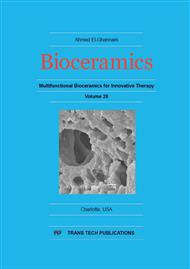p.215
p.219
p.223
p.228
p.234
p.241
p.246
p.252
p.257
Synthesis of Ag-Hydroxyapatite
Abstract:
Silver-bioceramics have a great potential to optimize the bone grafts materials to avoid microorganism infections on patients. The present study synthesized and characterized hydroxyapatite doped with silver (Ag), by an acidic route of precipitation method, and the proposal of the Ag-HA synthesis is to promote the bioactivity and bactericidal ability with less toxicity for organism. The samples were analyzed by X-ray diffraction (XRD) and Fourier transform infrared (FTIR) spectroscopy analysis. There was a pronounced grain growth after 1100°C HA and AgHA heat treatments for both HA and Ag-HA powders, observed by FEG-SEM analysis. XRD patterns of AgHA sintered at 1100°C showed HA as the main phase, but also a secondary whitlockite phase. However, 100% HA was observed for the Ag-HA samples heat treated at 700°C and 900°C. However, pure HA showed decomposition at 900°C. The acidic route of precipitation method showed to be effective for silver-doped hydroxyapatite production.
Info:
Periodical:
Pages:
234-238
Citation:
Online since:
November 2016
Keywords:
Price:
Сopyright:
© 2017 Trans Tech Publications Ltd. All Rights Reserved
Share:
Citation:


